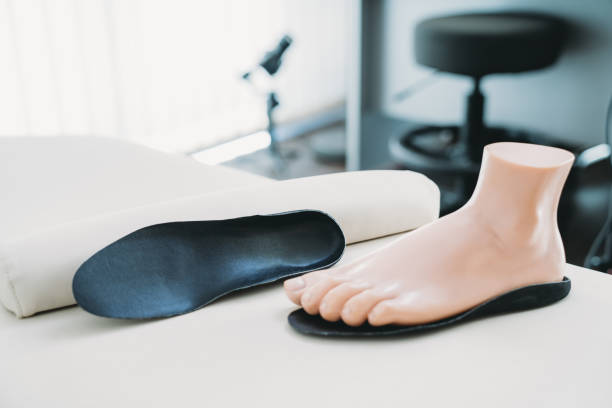
A podiatrist, or doctor of podiatric medicine (DPM), is a physician or surgeon who specializes in the foot, ankle and connected areas of the lower leg. They complete four years of medical school and gain experience in hospital residency programs.
A podiatrist can help you with many problems. For example, bunions can be painful and may worsen if they go untreated.
Connection Between Foot Health and Overall Well-Being
Your feet are incredibly important for your overall well-being. They serve as the foundation for your body and are crucial for balance, posture and general health. Yet, they are often neglected. As a result, foot problems can lead to pain and discomfort, as well as more serious medical conditions.
In many cases, these problems are avoidable with good habits and regular visits to a podiatrist. For example, keeping a healthy weight is one of the best ways to prevent common foot problems like bunions and hammertoes. In addition, it’s a good idea to elevate your feet for a few minutes every day to reduce swelling and improve blood flow to the feet. And finally, a foot massage can also help alleviate pain and relax the feet.
A podiatrist has specialized training in treating the foot and ankle. Their years of schooling and practice give them a deeper understanding of the complex structures of the foot. There are 26 bones, 33 joints (20 of which are actively articulated) and over a hundred muscles, tendons and ligaments in the foot and ankle. That’s a lot to keep track of!
Evolve Podiatry can treat a wide range of foot conditions including calluses, heel spurs, toenail disorders and nail infections. They can also offer guidance on proper footwear, provide hygiene tips and recommend exercises to maintain foot health and flexibility. They can even recommend assistive devices for those with chronic foot issues such as hammertoes.
It’s also important to see a podiatrist if you are diabetic. This is because diabetic foot care is a vital part of managing your condition, and podiatrists can identify early indicators of diabetes-related foot complications and treat them promptly to avoid more severe health problems.
Seeing a podiatrist can make a significant difference in your overall well-being. This is why it’s a good idea to visit one regularly, especially if you have any existing foot issues. If you need assistance paying for health-related services, consider the CareCredit credit card, which is accepted by thousands of healthcare providers and health-focused retailers. Use our Acceptance Locator to find a provider near you.
Podiatrists Treat Common Foot Problems
Your feet are all-in-one stabilizers, shock absorbers and propulsion engines that are instrumental in your overall health. Taking good care of them now can help you avoid painful foot, ankle and lower leg conditions in the future. If you are having problems with your feet, talk to your primary care physician about a referral to a podiatrist.
Podiatrist Kangaroo Flat have extensive training and experience in the treatment of foot problems. They use non-surgical treatments such as shoe modifications, shoe inserts, stretches and exercises and other methods to reduce pain and treat problems. They also treat many foot problems with medications and make surgical repairs if needed.
Some common foot problems treated by podiatrists include bunions, hammertoes, ingrown toenails, heel spurs, flat feet and arthritis. These conditions can be caused by poor footwear, age or hereditary factors. Other causes are injury, poor posture or health problems like diabetes. If you have any of these conditions, a podiatrist can help you find the cause and determine a long-term treatment plan.
Another common problem is a callus or corn. These hard areas of skin develop due to pressure or friction and can bleed or hurt. Podiatrists can remove these areas of dead skin hygienically and effectively.
Heel pain is a problem often caused by tight shoes and overpronation. A podiatrist can recommend a variety of treatment options for this condition including orthotics, injections and other measures to alleviate pain.
A podiatrist can also diagnose and treat other health problems affecting the feet and ankles such as nerve disorders, bone deformities and circulatory problems. In some cases, podiatrists work with other specialists such as orthopedic surgeons and vascular doctors to provide care for their patients.
When looking for a podiatrist, look for the letters DPM after their name. This indicates that they have completed years of rigorous podiatric medical school and hospital-based residency training, making them uniquely qualified to care for your feet. In addition, they are members of the APMA and have dedicated their lives to helping people keep their feet healthy. So take the time to find a podiatrist near you and commit to taking good care of your feet!
Podiatrists Can Help You Prevent Foot Problems
In addition to treating foot problems that arise, podiatrists also offer preventive care. They can advise you on proper shoes and how to walk, stand, and run properly to avoid foot injuries. They can also prescribe custom orthotics to help correct any irregularities in your feet or ankles that may be causing pain or affecting your gait.
Podiatrists are especially skilled in treating painful conditions of the feet and ankles that occur as a result of diabetes. These include blisters and bunions, which are both caused by friction, and neuromas, a condition that causes an intense burning or tingling feeling in the feet. This is often caused by compression of the nerves in the feet and is more common in women who wear narrow high-heeled shoes.
Regular visits to a podiatrist can also help you avoid serious complications like foot ulcers and infections, which are more common in people with diabetes. People with diabetes should visit a podiatrist at least twice a year and more frequently if they experience changes in their feet.
A podiatrist is trained to look at the way you stand, move your feet and ankles and see if you have any problems with your skin or nails that might indicate an underlying issue. For example, a red or discolored nail could indicate a fungal infection and dry skin and flakiness might point to conditions such as psoriasis or athlete’s foot.
A podiatrist can also provide you with treatment if you have an existing problem like painful corns or calluses, which are thick areas of dead skin that form on the bottoms of your feet. They are often caused by ill-fitting shoes and can be very painful if left untreated. Podiatrists can help you remove the hardened skin, ease the pain and advise you on how to prevent it from recurring.
Podiatrists Can Help You Deal With Foot Pain
If you have pain or injury in your feet and ankles, seeing a podiatrist is an excellent idea. This kind of health care professional is qualified to diagnose and treat most problems that affect your feet and ankles. Podiatrists have undergone years of rigorous schooling and hospital-based training, making them uniquely qualified to treat the foot and ankle.
A podiatrist can help you with a variety of conditions and injuries, including bunions, hammertoes, neuromas, ingrown toenails, corns, calluses, athlete’s foot, gout, arthritis and flat feet. They can also offer recommendations for proper foot care, footwear and physical activity that will keep your feet healthy.
For example, if you have heel pain, it could be from an overuse condition called plantar fasciitis, which involves inflammation of a thick band of tissue that runs across the bottom of your foot and connects to your heel bone. Symptoms include pain and stiffness in the heel area, especially when you first start walking or standing, and tenderness in your calf muscles and Achilles tendon. Treatment can range from stretching routines, wearing shoes with arch support and adding in-shoe padding, to medication, steroid injections or surgery.
Other common foot conditions podiatrists can treat include bunion bumps, which form on the joint at the base of your big toe. This condition can cause severe pain if left untreated and may lead to other foot deformities like hammertoes or crooked toenails. Podiatrists can treat bunions by removing the excess skin, trimming the toenails and possibly using an orthotic device or medication.
Another common foot problem is neuromas, which occur when the nerve that leads to your toes becomes irritated and compressed in the lower leg. A podiatrist can treat this issue with prescription drugs, physical therapy and recommending specific footwear or inserts.
The best way to avoid getting painful foot, toe, ankle and lower leg problems is to visit a podiatrist when you are healthy. A podiatrist can give you personalized advice and recommend treatments for preventing foot problems before they start. By taking this proactive approach, you can enjoy your life without paying the price of foot and ankle pain or serious medical complications down the road.




